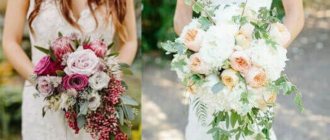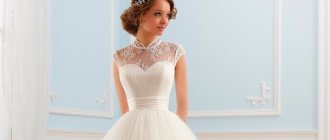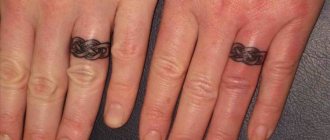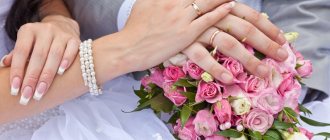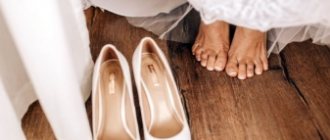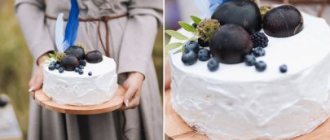What does a bride pay attention to first when choosing a wedding dress? Of course, on the style and fabric. Usually girls know in advance which material is preferable for them. Those who dream of a classic look will probably choose satin, silk, chiffon or lace. Original brides can turn their attention to fabrics such as jacquard, velvet or even denim.
Advertising - Continued below
We invite you to consider the most popular “wedding” and not so popular fabrics in more detail: and learn about their features, pros and cons.
Satin wedding dresses
Atlas. Photo: Crafts Fair, fabric store “Emerald Owl”
Satin wedding dress. Photo: sv-valens.ru
Satin is one of the most popular materials for wedding dresses. Literally from Arabic this word is translated as “smooth”. The shiny surface of satin wedding dresses has attracted brides throughout the 20th century. Satin is sometimes even called wedding dress fabric. This lightweight and pleasant-to-touch material is suitable for almost all classic wedding styles.
Thick or light fabric for the bride's dress
Suitable fabrics from which wedding dresses are sewn also include the following options:
- Lace is one of the most popular materials recently. It always looks luxurious and expensive, which is what many dresses lack. Lace skillfully combines with almost any fabric. In addition, it can be used as a base material. Real lace fabric holds its shape perfectly, has several colors and fits tightly to the figure, emphasizing all the charms and curves of the silhouette.
- Crepe is a material that is rarely used for sewing wedding items. There are several types: smooth and dense. Most often, smooth is used at wedding ceremonies.
- linen is a unique option that will make you feel light and free in the hottest and hottest weather. The bride will look especially good at an outdoor ceremony in the forest or on the seashore.
- taffeta is a material that can combine such qualities as rigidity and shine. Basically, this fabric is suitable for cold evenings. A large number of different styles are sewn from it. This is because taffeta is ideally able to keep its shape. Models such as mermaid and godet look especially beautiful in this design.
This is interesting: How to choose a veil for a wedding dress?
Tulle wedding dresses
Fatin
Wedding dress with a full tulle skirt. Photo: olga-welling.ru
Tulle is in second place in popularity. It is also used when sewing classic styles such as “Princess” or “Mermaid”. Tulle is a translucent and lightweight fabric that, when applied in several layers, maintains volume. Tulle wedding dresses can be different: with a multi-tiered or torn skirt, in a classic style or original with tulle flowers.
Advertising - Continued below
Chiffon wedding dresses
Chiffon. Photo: modelyersha.ru
Chiffon wedding dress. Photo: afrodita-sv.ru
Chiffon is a light and almost weightless fabric. Most often, scarves or summer sundresses are made from it. In wedding dresses, chiffon is most often used for decoration. For example, when creating a voluminous cloud for an airy skirt. Chiffon is indispensable if the girl chose a classic ball gown for her wedding. The advantage of this material is its low price. Although a few centuries ago everything was different: chiffon dresses were worn exclusively by royalty and they were very expensive. Today chiffon is available to everyone. At the same time, fluffy chiffon dresses still look great!
Lace wedding dresses
Lace. Photo: itsmyday.com.ua
Lace wedding dress. Photo: sv-valens.ru
Lace wedding dresses are back in trend this season. This luxurious, sexy and at the same time lightweight fabric is loved by fashionistas all over the world. The thing is that lace can look completely different - it all depends on the style. For example, a closed, fluffy dress that has a lace top and a satin skirt will make the bride’s image more modest and noble. A completely lace and tight-fitting wedding dress, on the contrary, turns a girl into a fatal and captivating beauty.
Styles and models
The following models are popular.
Closed
A closed satin item is not an option that is suitable for modest girls, as for some reason people think. The advantage of the outfit is that it fits tightly to the figure, showing others the advantages of the figure. Popular options are the buried type with a horizontal neckline, sleeveless, and a mermaid skirt.
Open
An open white satin dress with a full skirt is perhaps the most popular option among brides. This dress is suitable for a wedding ceremony and turns a girl into a real princess. The advantage is that the corset tightens the waist, making it visually narrower, and the cups emphasize the bust.
See also
Stylish women's models of high-heeled boots for 2021 and what is best to wear such shoes with
With sleeves
Sleeves can be not only long and tight, but also three-quarter, short, made of transparent fabric. In any case, they will draw attention to beautiful hands, thereby distracting attention from flaws.
Curvy
Models with a full skirt are always popular, so a girl can’t go wrong by choosing such an outfit. But in order not to be considered old-fashioned, it is important to choose a laconic and discreet top of the outfit.
With pockets
During the celebration, some brides do not know where to put their hands. Until recently, all wedding dresses had no pockets.
Now the designers have taken care and created options that have discreet holes for convenience.
Empire style
With the help of an empire style dress, it creates a sophisticated feminine silhouette. But it is important that the girl has an hourglass figure, otherwise all efforts will go down the drain.
With a train
A model with a train will turn even a dress of the simplest cut into a real work of art. The trend is for options with an asymmetrical skirt, medium fullness, as well as models in which the train is made of lace or decorated with rhinestones.
Little mermaid or fish
Mermaid is a style with a tight skirt that has a sharp flare from the middle of the calf. This model turns a woman’s figure into a figurine, hides wide hips, and makes the figure overall proportional.
A short
Short wedding dresses are chosen by brave people who want to surprise others even at the wedding ceremony. A popular mini dress with a corset, sleeveless, asymmetrical skirt and transparent train.
With lace
The lace top on the dress will instantly transform your look into an elegant and feminine one. Complex lace patterns do not require a lot of additional accessories.
Direct
A straight midi dress makes the look elegant and discreet. But you shouldn’t think that such clothes are boring - on the contrary, they demonstrate all the advantages of a beautiful figure.
See also
Fashionable jeans trends for the fall 2021 season, stylish models and what to wear with them
Guipure wedding dresses
Guipure
Guipure wedding dress. Photo: sv-valens.ru
Guipure is a material for graceful and sophisticated brides. It appeared in the 16th century in Italy, when its pattern was in the form of twigs and leaves. Now the patterns may be different, but floral motifs still prevail. Guipure is very often confused with lace; these materials are indeed very similar, the main difference is that synthetic threads are added to guipure. This makes the fabric more durable.
Guipure: patterned magic
The first openwork paintings appeared in medieval Italy during the Renaissance. At first these were narrow strips with jagged edges and images of curls and flowers. Over time, they learned to combine them into fabrics, from which they began to make curtains, bed canopies, collars and cuffs for noble people.
Despite its Italian origin, the name of the new fabric was given by the trendsetters - the French: “guipure” in translation sounds like “airy lace”. Guipure is a fabric with a characteristic relief pattern, the individual elements of which are connected by the finest mesh. Several methods are used to make it:
- “Yank it out.” Following the contours of the pattern applied to the canvas, individual fibers are pulled out of it. Then the resulting pattern is secured by wrapping it with a thin thread.
- "Etching." Patterns are embroidered on synthetic fabric with cotton or silk threads. Then it is placed in a special composition that dissolves synthetics, and only patterns and weaves from natural fibers remain.
- Using programmable machines. The most modern method that makes it possible to produce guipure fabrics with pre-programmed patterns on an industrial scale.
Guipure fabrics can be either natural - from cotton or silk fibers, or artificial - from viscose or synthetic - from polyester.
Interesting to know! There is stretch guipure - a material in which lycra is added for firmness and elasticity. Products made from this fabric fit tightly to the figure, repeating the slightest curves. In wedding dresses, stretch guipure is most often used to sew bodices or sleeves.
Lace guipure fabric for sewing wedding dresses has the following important properties:
- transparency and lightness - the material perfectly allows air to pass through and does not “float” the body;
- dimensional stability. Guipure holds its shape well and drapes with soft folds;
- wear resistance. Even despite the apparent airiness, the fabric has sufficient strength.
At the same time, when choosing guipure for sewing a bridesmaid dress, you should not lose sight of some of the nuances inherent in this material:
- Excessive openness does not correspond with the image of the bride, so you will have to use lining fabrics.
- Guipure made from synthetic fibers can be excessively stiff and irritate exposed skin.
- If handled carelessly, ties and tears may form on the fabric.
- The guipure is folded in the cut. When deciding how much material you need to purchase, you definitely need to make a large reserve for joining patterns and designs.
Guipure looks very beautiful in combination with satin, silk, viscose, leather and even fur.
Caring for guipure products is easy. The dress can withstand machine washing well if the water temperature does not exceed 400C. Guipure clothes do not need ironing.
A wedding is an unforgettable event, in preparation for which it is important to consider every detail, even the most insignificant. Therefore, when choosing textiles for a newlywed’s dress, you need to very carefully consider the combination of style, color, and texture of the material, so that nothing overshadows the newlyweds’ magic of their holiday.
Denim wedding dresses
Denim fabric. Photo: Nazya.com
Denim dress. Photo: sdress.ru
A denim wedding dress is an original option for an extravagant and fashionable bride. Denim is a symbol of freedom and independence of thought. Today, a dress made of jeans can be found in the wedding collections of popular designers: most often it is used to sew a corset for a dress or to trim a skirt. If you are hesitant to wear such a dress, but you like this fabric, there is a compromise: separate details and elements of the wedding dress. This could be a denim shirt, vest, jacket or brooch.
Velvet wedding dresses
Velvet. Photo: mytextile.ru
Velvet dress. Photo: radelya.ru
Velvet has always been considered a royal material; it was used to sew clothes for courtiers and also decorate the palaces of kings. Today velvet is one of the most trendy materials. Gorgeous evening dresses are made from it, and it also fits into winter wedding style. Brides tend to choose velvet wedding dresses in unusual colors: red, green, cream and pale pink. In a white velvet dress in winter, a girl will look like a real Snow Queen.
Advertising - Continued below
Who is suitable for wedding dresses made of thick fabric?
Thick wedding dresses are suitable for brides who want to look expensive and aristocratic. Their volume suits fragile girls. Due to their ability to retain heat, dense materials are suitable for winter. They fit well into themed weddings of different stylistic trends. You can read how to choose a wedding style here.
Silk wedding dresses
Silk
Silk wedding dress. Photo: pronovias.com
Silk wedding dresses are a special love of fashion designers around the world. After all, there is, perhaps, no other such sparkling and elegant fabric. Now silk is used to sew dresses in a rustic style. Silk has only two drawbacks: it wrinkles a lot, and can also emphasize figure flaws. Therefore, the bride needs to be more careful when choosing: a silk wedding dress should fit you perfectly.
Organza wedding dresses
Organza. Photo: poshvu.ru
Wedding dress with an organza skirt. Photo: svadbagarderob.ru
Organza is a translucent thin fabric that is woven from several types of fibers. Most often, fashion designers use organza when sewing skirts for wedding dresses. Organza wedding dresses are created for those brides who want to feel like a fairy-tale princess - they look extremely impressive! Very often, organza acts as an additional decoration for a dress - ruffles, flounces, frills. The advantages of organza are that it hardly wrinkles, retains its shape for a long time, is very durable, and at the same time light and pleasant to the touch. There is only one drawback - you need to iron it especially carefully.
Taffeta: many-sided beauty
Translated from Persian, “taffeta” means “woven fabric”. This beautiful shiny fabric was brought to Europe and Russia by Persian and Arab merchants at the beginning of the 16th century. At first, taffeta was used as a lining for expensive fur coats, caftans and hats. And only over time, having appreciated all the advantages of the fabric, they began to sew luxurious ball gowns for noble ladies from it.
Taffeta owes its smooth, shiny surface to a special plain weave of fibers with a high degree of twist: this fabric is thin, but very dense. Depending on the type of fiber used to produce taffeta, it can be of several types:
- silk;
- cotton;
- viscose;
- acetate.
Taffeta made from artificial and synthetic threads is in many ways not inferior to natural ones, but is much lower in cost, which significantly reduces the cost of the product. According to the type of dyeing, taffeta can be either single-color or printed, with a pattern applied using hot printing.
Interesting fact! Shanzhan taffeta looks very attractive - an iridescent fabric that acquires a new shade when the viewing angle changes. This effect is achieved through the use of multi-colored threads for the warp and weft.
Very often, “crumpled” taffeta is used for wedding dresses. To get multiple creases and folds on the material, it is twisted and passed under a hot press. Thanks to its undoubted advantages, taffeta is one of the most popular materials for bridesmaid dresses:
- Wear resistance: resists mechanical stress - does not tear, does not rub.
- Form stability:. drapes beautifully, forming large, rigid folds.
- Water-repellent properties: the dense weave of the threads prevents the fabric from quickly getting wet and losing its appearance.
But this wonderful material also has disadvantages that need to be taken into account when sewing a wedding dress:
- taffeta frays a lot when cutting and sewing;
- the fabric wrinkles significantly, so it is not suitable for all styles;
- The material may shrink when washed.
In addition, it is very important to provide the product with proper care so that the dress does not lose its beauty for as long as possible:
- Washing can be done either by hand or by machine, but in any case the water temperature should not exceed 300C.
- It is better to replace washing powders with liquid detergents.
- Taffeta products cannot be wrung out. You need to carefully hang the dress and let the water drain, then dry it away from heating devices.
- When ironing, the iron regulator should be set to minimum; dresses should only be ironed from the wrong side.
Important! Taffeta clothes should be stored on hangers in special cases. The use of thick plastic bags is not recommended, as the fabric may “suffocate” and crumble.
Linen wedding dresses
Linen. Photo: izolna.ru
White linen dress. Photo: dd-shop.ru
Naturalness and naturalness are held in high esteem today! Over the past few years, fashion has increasingly been looking towards simple materials. One of the most popular is linen. Linen wedding dresses are chosen by those who are close to rustic, vintage or Provence style. Suitable styles for this material are sundresses, A-line dresses and loose-fitting dresses.
Advertising - Continued below
The biggest advantage of linen dresses is their hypoallergenicity. In this outfit, any bride will feel comfortable and cozy throughout the entire celebration. Well, and, of course, we must not forget about the touching romantic charm that surrounds any linen wedding dress.
Satin wedding dresses
Satin. Photo: textile-home.ru
Satin wedding dress
Satin is a dense material with a shiny and smooth surface. Sometimes satin is confused with silk or satin: this happens because the basis of the fabric can be different fibers, including silk. But satin, unlike silk, is very durable and almost does not wrinkle.
Other important advantages include that it does not electrify and is pleasant to the touch. Brides who choose satin wedding dresses should remember that in this material any girl will look quite strict and restrained. Therefore, satin is perfect for brides 30+ and those who prefer laconic elegance.
Advertising - Continued below
How to choose the right wedding fabric
Before deciding what fabric the wedding dress will be made from, you should take into account several important factors so that the upcoming celebration is not overshadowed by unpleasant surprises.
- Breathability. No matter how dense the material is, it should allow the skin to “breathe” so that the bride feels comfortable even in a stuffy indoor room.
- Elasticity and strength. A wedding is not only a ceremonial part, but also fun competitions and fiery dances, so the fabric should not hinder movements or tear even from minor efforts.
- Wrinkle resistance. A wedding photo shoot is a memory for the newlyweds for life. It is very important that the bride’s outfit remains neat and does not wrinkle during the evening.
- Suitable for the season. For a summer wedding, thinner, lightweight fabrics that won't feel too hot are best. For celebrations in the cold season, the material may be heavier.
- Matching style. You should not choose thick fabric, such as brocade, for a fluffy outfit with a crinoline, as the draperies will look rough and sloppy.
- Fit to figure. It should be remembered that all shiny materials visually add volume, so if the bride does not have model parameters, then it is better to stick to matte fabrics.
- Material consumption. Some fabrics require careful selection of patterns or patterns, so they should be purchased in excess.
It is important that accessories and trims match the chosen fabric, as these additions can make even an inexpensive material sparkle with new colors.
Although fabrics made from natural fibers have a higher cost than artificial and synthetic materials, they are often preferred because they look expensive and harmonious in wedding dresses.
Let us briefly consider all types of fabrics that are used for sewing wedding dresses.
Taffeta wedding dresses
Taffeta
Taffeta wedding dress. Photo: rstelle.ru
Taffeta came to us from Persia; this word is translated as “woven.” It is made from twisted threads: the fabric is dense, and at the same time light and thin. A classic A-line taffeta wedding dress is the perfect outfit that will suit any bride, regardless of body type.
Fabrics for decoration
Many wedding dresses have additional decorative trim. That is, in addition to the main type of fabric, another material is used.
It is necessary to make the dress more beautiful and the image complete.
Brocade
Wedding dress made of thick fabric.
A special fabric that not so long ago was considered a sign of luxury and wealth. Currently, brocade has become increasingly used due to its lower price. The cost fell due to a completely new production, which made it possible to reduce the basic price.
This is interesting: Choosing tulle wedding dresses together: advice from professionals
Brocade is distinguished by the thickness of the material and excellent qualities. It is ideal for warm winter wedding ceremonies. With the help of brocade you can not only complement a wedding outfit, but also sew a cape and bolero.
Fatin
One of the oldest materials from which thick fabric wedding dresses began to be made. Initially, the vast majority of wedding dresses were made from tulle. Much later they began to leave him. Nowadays, such fabric is increasingly used only as finishing.
Tulle can be used as a single piece of fabric or as cut pieces. For example, it could be a voluminous one-piece skirt. Or, as an option, the material is used only in equal pieces in the form of peculiar patterns.
Tulle must be used extremely carefully. Because this is a material that visually adds extra pounds.
Organza
Ideal for additional decoration. This is a fabric that is a mixture of several materials. The base is viscose and silk. Several materials are twisted together and the result is a fairly dense and beautiful fabric.
Organza looks very beautiful; fancy patterns are created from it. In addition, the material is very dense and durable; it is most often used as drapery for the neckline or back.
Chiffon
A fabric that is created only to give the dress additional airiness and tenderness. Chiffon should never be used as the main material.
Such fabric does not hold its shape and it is impossible to sew any model from it. However, fashion designers treat it with special love. After all, it allows you to create original forms.
Jacquard wedding dresses
Jacquard. Photo: modelyersha.ru
Jacquard wedding dress. Photo: ldweddingculture.com
Jacquard is a smooth, lint-free fabric with a special pattern: it is created by intertwining several threads. These threads can be made from different materials: natural, synthetic or mixed. Wedding dresses made of silk jacquard look especially impressive.
The advantages of this fabric: strength, wear resistance and durability. Of the minuses: jacquard wedding dresses have a high price. By the way, it is believed that jacquard is the ideal fabric for a short wedding dress.
